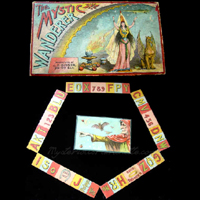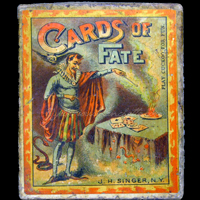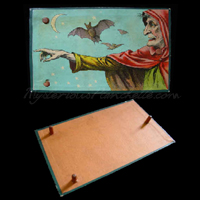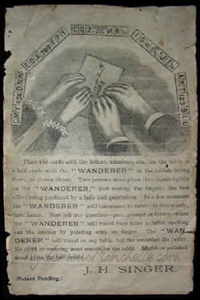Jasper H. Singer's eponymous company was one among dozens of prolific New York game "jobbers" in the 1880s through early 1900s that maneuvered the intricate landscape of toy manufacturing in the period. This era marked incredible leaps in printing innovation where hand-colored gaming materials gave way to cheaper but no-less-extravagant full-color lithography, and companies such as McLoughlin Brothers, Milton Bradley, Parker Bros, E. I. Horsman, and J.H. Singer flourished. The quality of these companies' products mark the golden age of American board games, with stout cardboard or wood boxes, bone dice, metal components, and turned wood tokens and pawns. Board games were finally departing from their educational roots and becoming more socially-acceptable recreational diversions for adults, and the result was an explosion in popularity and profits for those companies that produced them.
In this environment, J.H. Singer flourished. The founder filed patents for games, including a toy theater stage and an early tabletop pinball game. One of the company's tabletop games was the first to use the phrase "Table Tennis," which other companies would later appropriate for Ping Pong. The company, like many other planchette manufacturers, were largely "jobbers." Deciphering the rather incestuous relationship between toy companies of this period is an exercise in futility, but competitors might print another company's boxes for a fee, as Singer did with Selchow & Righter. Or, the firm might have tokens or other components produced out-of-house, assemble them in their own warehouses, and then wholesale the finished product to their competitors for eventual sale to the retail trade. Such products produced in this chaotic free-trade environment included "Jumping Frog," "Cuckoo," and the paranoia-invoking "Where Do You Live?"
The year 1900 marked a decline in the popularity of board games, with only the healthiest firms like Singer rivals Mcloughlin Brothers surviving. By 1902, J.H. Singer filed for bankruptcy. Luckily for us, the company produced the stunningly beautiful Mystic Wanderer planchette set before passing into obscurity. Debuting around 1893, the planchette was housed in a stout cardboard box, featuring a marvelous color lithograph of some oracle conjuring mystic fire from a nearby cauldron, a suspended cabinet of curiosity-invoking crocodile, and a calmly posing griffin, as well as the stylized title of the contents. Within, five long, brightly-colored letter cards carry a random assortment of letters, numbers, and a couple of mixed fortunes, including a wedding ring and a good luck horseshoe.
The planchette itself is equally colorful, with an old crone witch and her bat familiar pointing the way toward the plank's front with a crooked, outstretched finger beneath the light of a sliver of moonlight. What the plank has in personality, it lacks in form. The board itself is rectangular, with no stylized shape or definition, and is of tough cardboard construction overlayed with the lithographed paper. Three rounded wood pegs act as castors, and the board's bottom is a plain brown paper that covers the upper label's overlay edges. Overall, the set is a beautiful representation of the game maker's art of the period. While it isn't a writing planchette per se, it is a work of art in its own right, and highly collectible.










